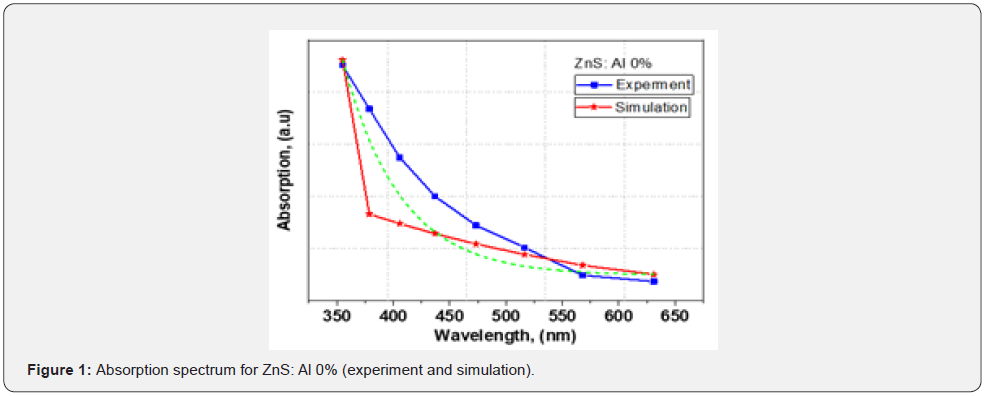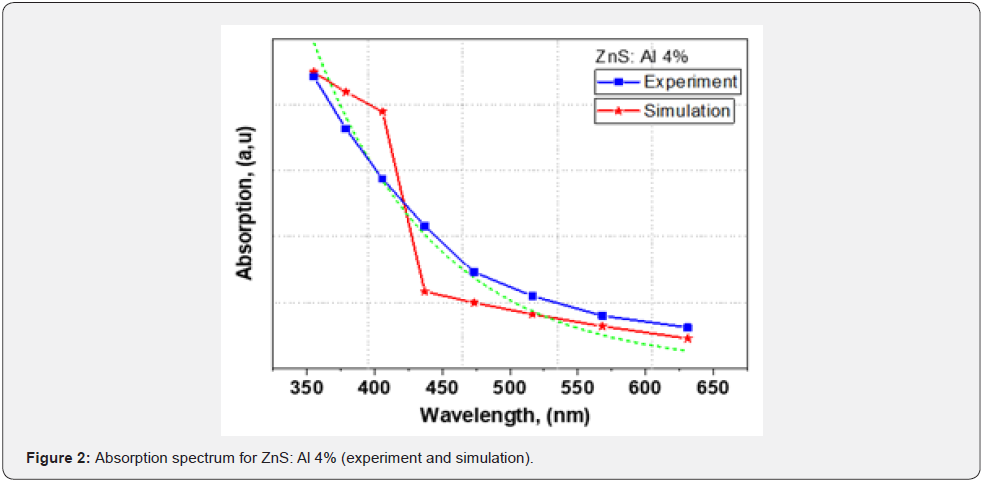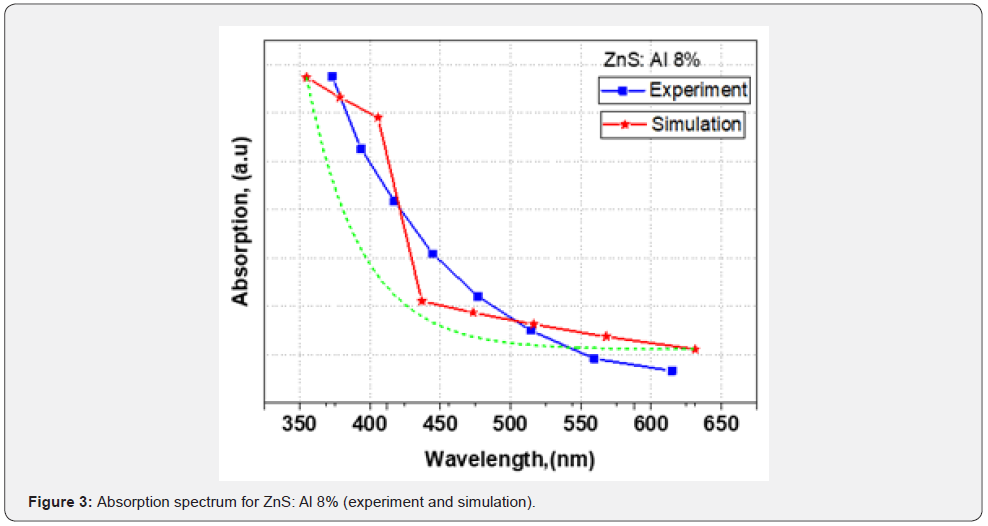Investigation on Effect of Energy Loss on the Optical Properties of Aluminum Doped Zinc Sulfide
A A Ahmed* and M D Abdulla
Department of Physics, Sudan University of Science and Technology, Sudan
Submitted: March 01, 2023; Published: March 14, 2023
*Corresponding author: A A Ahmed, Department of Physics, College of Science, Sudan University of Science and Technology, Sudan
How to cite this article: A A Ahmed and M D Abdulla. Investigation on Effect of Energy Loss on the Optical Properties of Aluminum Doped Zinc Sulfide. JOJ Material Sci. 2023; 7(4): 555719. DOI:10.19080/JOJMS.2023.07.555719
Abstract
The interactions between the ion beam and matter are extremely intricate processes that involve a wide range of phenomena. The optical parameters for Zinc Sulfide NPs such as absorption as function of Aluminum content measured used UV spectrometer. The energy losses, projected range of zinc sulfide, doped by aluminum were modelled in this work using the SRIM code 2013. The energy loss values, as well as the range of hydrogen ions in the samples, were found was between 1.7 and 3.1eV used to implant the samples. The results show that the energy loss and projected range of ions in the materials may be utilized to calculate the optical properties. The acquired results were compared to experimental data. Calculation specifics are provided and explained.
Keywords: Optical properties; Absorption; Energy loss; Projected range
Introduction
The goal of this study is to utilize the SRIM code to simulate the optical characteristics of ZnS thin films doped with Al at various concentrations and compare them to experimental data. Charged particles are often classified as light or heavy [1]. The comparison of theoretical and experimental data will be the emphasis of this investigation. Protons’ interactions with matter are classified into three types: protons-electrons, protons-nuclei, and protons-atoms. Because their rest mass is larger than that of an electron, most protons travel in a nearly straight path. In this work, however, proton interaction mechanism factors such as energy loss and predicted range are employed to determine absorption for the selected materials. Three separate impact particle energy regions influence the loss of energy by protons in materials [2].
Furthermore, protons often lose energy in matter due to coulomb forces. As a result, this investigation will be confined to scenarios when the incident proton’s energy ranges from 0.002 to 0.004eV. The stopping power (S) of protons is an incredibly essential quantity in this region of interest for studies of nuclear energy loss and atomic physics. Several recent investigations have centered on the estimates of energy loss, stopping power, and proton range in matter [3]. Furthermore, significant improvement has been achieved in heavy ion stopping power measurements [4]. Many studies studied and reported on the heavier ions and the proton theory of stopping power [4,5].
The SRIM function conveniently evaluates and calculates the stopping power (S) and range (R) tables [6]. The SRIM code is a Monte-Carlo simulation that tracks ion transport in the target (specifically, the stopping (S) and range (R) of ions (I) in matter (M). The energy loss or physically similar characteristics are available elsewhere [4-6]. There is limited information in the literature on the interaction of protons with Al doped ZnS placed on soda-lime glass [7]. As a result, more research is required to compute the optical properties of the elements of interest, such as absorption, transmittance, and band gap energy. As a result, modeling of electrical stopping powers and element ranges is significant not only theoretically but also in numerous applications. The transparent semiconducting ZnS is well-known; it is an n-type, wide-band gap (3.7eV) semiconductor [7]. Because of these characteristics, ZnS films are useful for a wide range of applications [8, 9]. However, various research on ZnS thin film deposition has been conducted [9]. The deposition of ZnS thin films on substrates has several uses. One of the most significant flexible substrates is soda-lime glass [10,11].
To deposit ZnS films with specific qualities and good adhesion on soda lime substrates, a thorough investigation of the films’ stopping power, energy loss, and range properties is required. The methods utilized to produce ZnS thin films on substrates described in the literature include RF sputtering [12], evaporation [13], spray pyrolysis [14], ion beam deposition [15], and pulse laser deposition [16].
Materials and Methods
Samples preparations
ZnS were produced on glass substrates using the pulsed laser deposition technique. Sigma-Aldrich Company supplied high quality ZnS (99.99% percent) in the form of tablets, which was utilized as an evaporation source material in a molybdenum boat. Before deposition, the glass substrates were cleaned in an ultrasonic bath with deionized water, acetone, and ethanol for 20 minutes and dried with purified nitrogen gas. The average evaporation rate was kept constant at 2 A/s. The chamber pressure was kept at 105 tor. The thin layer was deposited at ambient temperature. The evaporation source was 30 cm away from the glass substrate.
The optical properties for ZnS nanostructures were investigated using UV-VIS spectrometer in the range of visible wavelength. The results of absorption spectra for the samples 0%, 4% and 8% as a function of aluminum content shown in figures 1-3 respectively. A good agreement founded with published data for the same materials.



Computational methods
The SRIM-2013 computer code was used to calculate the electronic and nuclear stopping powers, as well as the range of ion beams with energies ranging of visible range from 1.7 to 3.1eV, on ZnS thin and Al doped ZnS thin. For samples, simulations were carried out utilizing thorough calculations and complete damage cascades investigation.
The value of the intensity was calculated by the formula in equation (1) [17]:

Where, I is the intensity of the ions beam emitted from the samples, I0 is initial intensity of the beam, Q is energy losses for the ions obtained from SRIM represented as dE/dx, λ is wavelength, r is range of the ion in sample obtained from the SRIM data known as projected range. The intensity of light passing through the sample is measured for each wavelength of light travelling through the sample. This is sometimes referred to as I0, which stands for Intensity. The intensity of light flowing through the sample is also measured for that wavelength, which is represented by the sign I. If I is smaller than I0, the sample has certainly absorbed part of the light.
A simple amount of arithmetic is then performed on the computer to transform this into the absorbance of the sample, denoted by the symbol A.
The connection between A (the absorbance) and the two intensities is provided for reasons related to the form of the Beer-Lambert Law (below).

The diagram of the absorption for the films depicted in figures 1-3 the absorption behavior for the ZnS thin film shown the same as well as an increase in the Al content.
Results and Discussion
Absorption
The absorption spectra for all the samples 0%,4% and 8% of Aluminum doped ZnS shown in figures blew drawn according to the attenuation of the energy of the ions when it passes through the samples, use the values of the energy losses as main factor for the equation of the Beer-Lambert Law (2) represent the attenuation coefficient.
For the experimental results the absorption coefficient decreased when the frequency of the incident ion beam became higher. Moreover, the simulation results for the same samples show the same pattern for decrees of the absorption spectrum. By comparing the spectra for Al doped ZnS thin film for all samples, the fit for the curve have been done (green curve) to produce perfect match with experimental curve for each sample. However, the SRIM code on a computer is highly valuable computational software that may help researchers gain additional data regarding ion implantation and material science.
Conclusion
SRIM code is used to compute the stopping power and range of protons in Al doped ZnS placed on soda lime. It was discovered that the absorption and wide gap of Al doped ZnS are highly dependent on Al concentrations. The examination of stopping power is critical to evaluate the detailed absorption of ion beams in matter. Because doping materials need costly experimental observations, precise data for numerical simulations is required. When the two spectra are compared, there is extremely good agreement between the experimental and theoretical. The current results of energy loss and range for these materials at energies ranging from 1.7 to 3.7eV might be relevant in studying physical properties with the effects of multiple ions on materials.
Acknowledgment
This work supported privately by the authors. There is no grant number or funding to declare. The authors appreciate the support and guidance of Prof. Mohammed Hassan Eisa from Imam Mohammed Ibn Saud University - Saudi Arabia.
References
- Eisa MH, Alfedeel AHA (2020) Simulation Properties of Thin Films of Indium Tin Oxide Deposited on Polymer Substrates. Digest Journal of Nanomaterials & Biostructures (DJNB) 15(1).
- Nastasi M, Mayer JW, Hirvonen JK (1996) Ion-Solid Interactions: Fundamentals and Applications. Cambridge Solid State Science Series, Cambridge University Press.
- El Ghossain MO (2017) Calculations of Stopping Power, and Range of Ions Radiation (Alpha Particles) Interaction with Different Materials and Human Body Parts. Int J Phys 5(3): 92-98.
- Ziegler JF, Biersack JP, Littmark U (1999) The stopping and range of ions in solids. In: Pergamon, New York, 1985, USA.
- Ziegler JF (1999) The Stopping of Energetic Light Ions in Elemental Matter. J Appl Phys 85: 1249-1272.
- Rauhala E, Barradas NP, Fazinic S, Mayer M, Szilágyi E, et al. (2006) Status of ion beam data analysis and simulation software. Nucl Instr Meth B 244(2): 436-456.
- Möller HJ (1991) Semiconductors for solar cell applications. Prog Mater Sci 35(3-4): 205-418.
- Ali MKM, Ibrahim K, Hamad OS, Eisa MH, Faraj MG, et al. (2011) Deposited Indium Tin Oxide (Ito) Thin Films by Dc- Magnetron Sputtering on Polyethylene Terephthalate Substrate (Pet). Rom J Phys 56: 730-741.
- Knickerbocker SA, Kulkarni AK (1995) Estimation and verification of the optical properties of indium tin oxide based on the energy band diagram. J Vac Sci Technol A 13(3): 1048.
- Hao L, Diao X, Xu H, Gu B, Wang T (2008) Thickness dependence of structural, electrical and optical properties of indium tin oxide (ITO) films deposited on PET substrates. Appl Surf Sci 254(11): 3504-3508.
- Tuna O, Selamet Y, Aygun G, Ozyuzer L (2010) High quality ITO thin films grown by dc and RF sputtering without oxygen. J Phys D: Appl Phys 43(5).
- Naseem S, Rauf IA, Hussain K, Malik NA (1988) Effects of oxygen partial pressure on the properties of reactively evaporated thin films of indium oxide. Thin Solid Films 156(1): 161-171.
- Seo DJ, Park SH (2005) Structural, electrical and optical properties of In2O3: Mo films deposited by spray pyrolysis. Physica B: Condensed Matter 357(3-4): 420-427.
- Liu C, Mihara T, Matsutani T, Asanuma T, Kiuchi M (2003) Preparation and characterization of indium tin oxide films formed by oxygen ion beam assisted deposition. Solid State Commun 126(9): 509-513.
- Ginley D, Roy B, Ode A, Warmsingh C, Yoshida Y, et al. (2003) Non-vacuum and PLD growth of next generation TCO materials. Thin Solid Films 445(2): 193-198.
- Ziegler JF, Ziegler MD, Biersack JP (2010) SRIM – The stopping and range of ions in matter (2010) Nucl Inst Meth Phys Res B 268(11-12): 1818-1823.
- Roy R, Choudhary VS, Patra MK, Pandya A (2006) Effect of annealing temperature on the electrical and optical properties of nanocrystalline selenium thin films. J Optoelectron Adv Mater 8(4): 1352-1355.
- Kumar V, Khan KLA, Singh G, Sharma TP, Hussain M (2007) ZnSe sintered films: Growth and characterization. Appl Surf Sci 253(7): 3543-3546.
- Bitri N, Ben BK, Isabelle LY, Bouzouita H, Abaab M (2017) Studies of physical properties of the Al doped ZnS thin films prepared by SprayJ Mater Sci: Mater Electron 28: 734-744.
- Jigi GM, Tizazu A, Asnake G (2021) Synthesis and characterization of aluminum dope zinc sulfide (Al:ZnS) thin films by chemical bath deposition techniques. Journal of Applied Biotechnology and Bioengineering 28(2): 55-58.
- Abdul JLM (2014) Study the effect of annealing on optical and electrical properties of ZnS thin film prepared by CO2 laser deposition technique. Iraqi J Laser 13: 29-35.






























